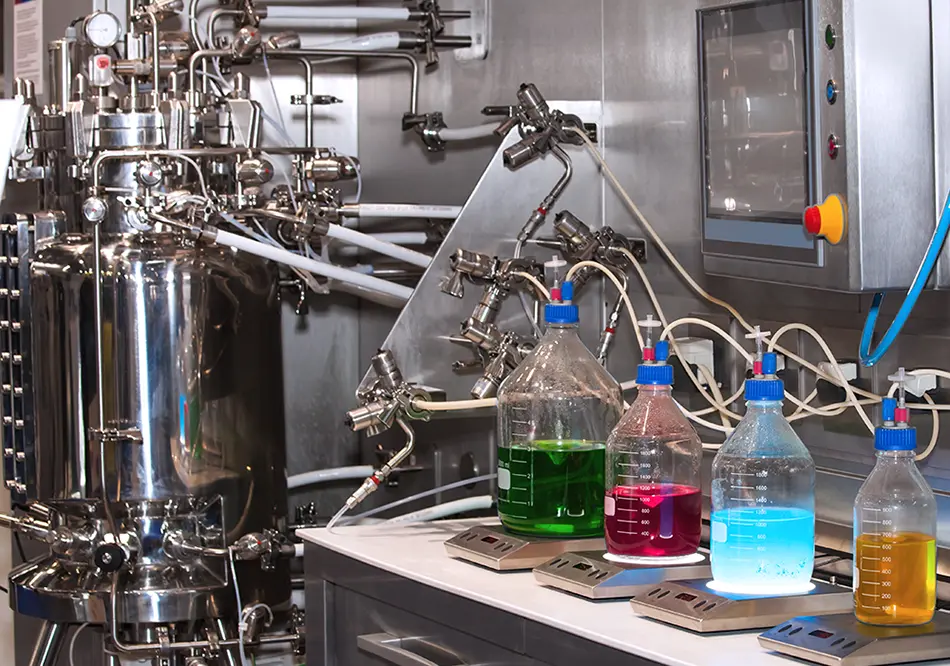Four Methods to Control pH in Bioreactors

Mammalian cells are only viable in environments with pH between 7.1 and 7.4. But the cells naturally produce carbon dioxide as a byproduct of respiration, driving pH down. Cells naturally have mechanisms to remove carbon dioxide and prevent toxic buildups, and buffering systems to keep their pH at healthy levels. Bioreactors need to mimic these features to ensure the cells can thrive.
What influences culture pH?
At that point, the pH of the culture needs to be raised. Historically, base was pumped into the culture medium. Now, newer bioreactor setups use macro spargers to introduce large bubbles of air or nitrogen. These bubbles don’t dissolve easily, so they strip the carbon dioxide from the culture, bringing it to the headspace of the bioreactor where it is removed.
Recent literature has looked closely at the most effective means of controlling pH in a bioreactor. Here, we rank four approaches to pH control, from least to most effective.
Least effective: Keeping pCO2 constant
pCO2 effects pH, but they aren’t tightly correlated
The main reason for this is that with small changes to pH within the realm of cell viability (pH 7.1 – 7.4), bicarbonate buffer in the (extracellular) medium will effect pCO2 according to Le Chatelier’s principle.
Also, mammalian cells generate lactate, in addition to carbon dioxide, as a byproduct of respiration. Lactate and CO2 both make the culture more acidic, but lactate’s effect on pH isn’t reflected in the pCO2 measurement.
After the buffer breaks and the pH starts to drop significantly, pCO2 and pH are much more closely related. But it’s still not a strong means of monitoring and controlling pH — which is the variable that actually matters to increasing cell titers.
Less effective: Pumping base into the culture
This method is most effective in:
- Smaller bioreactors, where the effects of uneven mixing and pH localization may be negligible.
- Environments with low pCO2 and low pH, where cells generate CO2which dissolves rapidly, further lowers the pH, and cannot be removed with sparging gases.
- Fermenters fermenters culturing microbial cells, which are hardier than mammalian cells. They can both handle increased agitation and mixing, and are less sensitive to pH fluctuations.
Pumping base doesn’t guarantee a constant pH throughout the bioreactor
These problems compound as bioreactor size increases, meaning that pumping base simply doesn’t scale up well. Mixing time and agitation both need to increase with bioreactor size to avoid worsening localization, but this comes at the expense of increased foam and shear stress.
Pumping in base also increases the osmolality (solute per kilogram of culture medium) of the culture. In larger bioreactors, this can decrease cell viability and product titer.
More effective: Combining pumping base and sparging gases
Pumping base has significant downsides, and sparging gases have significant advantages
Most effective: Using only sparging gases
Specifically, several factors make this method most effective:
- Sparge rates are limited only by the maximum flow rates of the mass flow controllers that feed the gases to the spargers. The specific micro- and macro- spargers can be engineered and scaled based on desired flow rates and known mass transfer principles.
- Gas bubbles from spargers can be evenly mixed and distributed more quickly than base, and with much less agitation.
- Sparging gases scales very well, because the sparge rate and bubble size often don’t need to change as the bioreactor scales. A 2018 study by Hoshan et al. kept sparge rate constant and simply increased headspace aeration to compensate for increased bioreactor size. They saw titers increased by similar amounts in both 30 L and 250 L bioreactors by simply setting up more optimized control loops between pH and sparged air.
Intelligent sparger engineering and control loop design are critical
Well-designed spargers, in contrast, will scale well and produce consistently high titers.